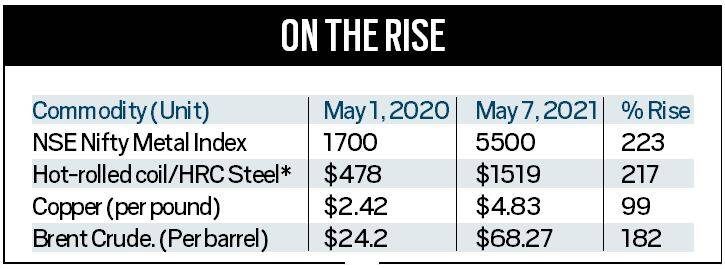Super Cycle of Commodities | 11 May 2021
Why in News
Recently, there has been an across-the-board rise in global commodity prices that is being billed as a new commodity super cycle.
- A commodity is a basic good used in commerce that is interchangeable with other goods of the same type. Commodities are most often used as inputs in the production of other goods or services.
Key Points
- About:
- A commodity super cycle is a sustained period of abnormally strong demand growth that producers struggle to match, sparking an increase in prices that can last years or in some cases a decade or more.
- Current Situation:
- Metals:
- Steel, the most commonly used input in the construction sector and industries, is at all-time highs, as most metals including base and precious metals prices have increased a lot in the last one year.
- Agricultural Products:
- Sugar, corn, coffee, soybean oil, palm oil — have risen sharply in the US commodities market, the effect of which is being seen in the domestic market, too.
- Metals:
- Reason: The new commodity super cycle is resulting from:
- Recovery in global demand (led by recovery in China and the US).
- Supply-side constraints.
- Loose monetary policy of global central banks.
- Investment in Asset Creation: It is also a result of money starting to hide in assets that are stores of value as there is an expectation that inflation may rise.
- Therefore it is fear of inflation that is leading to jump in prices and it is not demand driven.
- Concerns:
- It is leading to input cost pressures and is a growing concern, as it is not only expected to have a bearing on cost of infrastructure development in India but also have an impact on the overall inflation, economic recovery and policy making.
- Higher metal prices will lead to higher Wholesale Price Index (WPI) inflation and so the core inflation may not come down.
Loose and Tight Monetary Policies
- A monetary policy that lowers interest rates and stimulates borrowing is an expansionary monetary policy or loose monetary policy.
- Conversely, a monetary policy that raises interest rates and reduces borrowing in the economy is a contractionary monetary policy or tight monetary policy.
Inflation
- Inflation refers to the rise in the prices of most goods and services of daily or common use, such as food, clothing, housing, recreation, transport, consumer staples, etc.
- Inflation measures the average price change in a basket of commodities and services over time.
- Inflation is indicative of the decrease in the purchasing power of a unit of a country’s currency. This could ultimately lead to a deceleration in economic growth.
- However, a moderate level of inflation is required in the economy to ensure that production is promoted.
- In India, inflation is primarily measured by two main indices — WPI (Wholesale Price Index) and CPI (Consumer Price Index) which measure wholesale and retail-level price changes, respectively.
Core Inflation
- It is the change in the costs of goods and services but does not include those from the food and energy sectors. This measure of inflation excludes these items because their prices are much more volatile.
- It is important because it's used to determine the impact of rising prices on consumer income.
Way Forward
- The decision makers need to look at the mismatch in supply and demand and they need to find out where to invest, where to incentivise through the Production-Linked Incentive (PLI) Scheme to prepare themselves to deal with the situation.

